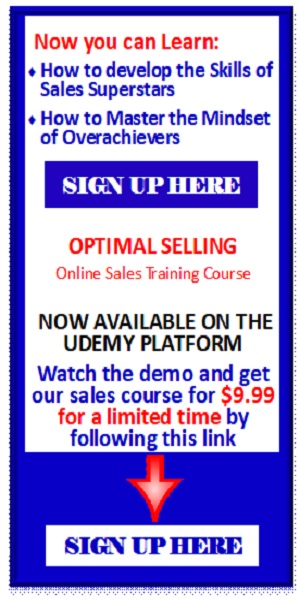Analyzing risk is an important element of assessing the prospects compelling reason to buy. It is often a negative factor meaning that the more risk there is from the client’s perspective the lower the possibility that they will buy from you. Risk is often a personal pain. Prospects may think “I can’t afford to make a mistake.” Or they may think that it “is wise to take the safe choice”. Many times, they will not know how to articulate the risk and they may not even be aware of their own fear. But the risk is there none the less. The job of the salesperson is to ask about it and force the discussion even if the prospect does not want to discuss it. So, the lesson is to analyze the risk yourself and get the prospect to discuss it even if the prospect tries to avoid it. And it goes without saying that sometimes the risk factor works in your favor, especially if you are the name brand or the incumbent. If that is the case you should be able to command a higher price … but that is the topic for another video.
Search Results for: pain
Effectiveness vs Efficiency
You can save time in sales by getting two decision makers in the room at the same time. That is much more efficient than seeing them one at a time. But it is not always the most effective way to handle a sales call. Suppose the two decision makers, both senior VP’s, are being considered for the position of CEO and you get them in a room to discuss your project which is a new software installation. Do you think either one of them will want to open up and tell you all the problems they are having with their rival sitting there listening to every word? I think not. What if I added the HR VP to the mix? In that case it is even less likely for them to open up. You are more likely to get posturing and platitudes than any true expression of the pain they might be in. I had it happen to me. The CEO was willing to move ahead with any training that either one of the VP’s felt they needed. He then called them both into his office together and asked them what they thought the biggest problem with their teams was. One of the VP’s asked if I could meet him privately and the other stated he had no problems that he could think of. The CEO then proceeded to say, “I’ll tell you what the problems are …” and listed several things the VP and his team were not doing. That VP pushed back and got into an argument with his CEO. He was so embarrassed he never wanted to see me again. That’s when the other VP asked to see me privately and he signed up for me to train him and his team. I learned my lesson and never let myself get in that position again.
Ask What Changed
Sometimes the sales process suddenly speeds up or slows down. A project that was dormant suddenly springs to life. Or, one that was moving along briskly suddenly comes to a screeching halt. When that happens (especially in the case when it speeds up) you should ask the prospect “what changed?”. The reason you ask is that things happen for a reason. And it is important that you know that reason. It might be the prospect got a visit from the EPA regulators and now they are under a deadline to remedy a situation. It could be that they were focused on a competitor and the competitor has slipped up for some reason and are now out of the running. In either of these cases the answer to the question will give you insight into the urgency of the situation, the pain of the prospect and the decision process of the prospect. It is also possible that nothing changed but in my experience that is rarely the case. Don’t be so excited by the project springing to life that you forget to ask what prompted the sudden change. If you do, you will miss a golden opportunity to get an advantage over the competition or some leverage in the negotiations to come.
Find Someone who Cares
Pipelines are bloated with prospects who think the solution presented is interesting or who want to buy something but haven’t bought yet. These deals usually don’t close. The reason is that there is not enough of a compelling reason to buy. The solution to this problem is to find someone in the organization who cares about the problem. They usually care about it because it affects them in some way. This makes the pain personal and personal pain is the biggest motivation to take action. The message is as simple as that. Find someone in the organization who cares about the problem.
Prep your expert
Experts can cause you problems if they you don’t handle them correctly. There should always have a reason to bring them on the call with you. It might be that they are there just in case there is a question you can’t answer. It might be to make the presentation about how you will solve the problem, or it might be to lead the effort in finding pain because the person you are dealing with is a technical person. It is important that whatever the plan is the expert knows what the plan and is ready to follow your direction. If they are just there in case a question comes up, make sure you tell them not to speak until you ask them to. To do otherwise is to invite disaster. If you are not careful they may take over the sales call in a misguided attempt to help you. This never ends well. In summary have a plan or don’t take the expert and make sure they know the plan and are ready to follow it.
Wants to do it vs will do it – Follow up
There can be a big difference between someone who wants your product and someone who will buy your product. Many salespeople get excited when the prospect exhibits interest or says that they want or need their product. However, if you stop with need or want, you may end up with a pipeline bloated with prospects who are never going to buy. The difference between “I want that” and “I will buy that” mostly lies in whether there is enough pain to “compel” action. The first step in qualifying a prospect is to make sure there is a compelling reason to buy. The compelling reason usually resides in the answer to the question “why do you want it” or “why do you need it”. It may take more questions than that and many minutes of conversation but eventually the prospect must reveal what is driving them to move forward. If they don’t then there will be no sale in the immediate future.
Wants to do it vs will do it
Are your forecasts inaccurate? Is your pipeline bloated with deals that never close? It might be because you don’t appreciate the difference between someone who will buy form someone who merely wants to buy. As I write this I want to buy a new car. The Lexus I have is getting older and there are some minor problems with it. Nothing major, there are just some minor annoyances. Plus, I like some of the features of the new cars. BUT, I am not in enough pain to buy one. There is no urgency. Besides I hate cars in general and don’t especially relish the task of buying one. Money is not the issue. If I was in front of a car salesperson, I would sound like a buyer and act like a buyer, but I would not be a buyer since there is nothing pushing me to buy. However, that could change. If my mechanic would alert me to a major impending expensive problem, I would suddenly have enough urgency to buy immediately. Don’t be fooled by people who give “buying signals”. Make sure they have enough urgency to buy in the short term. Ask questions. Dig deeper and you will avoid the dreaded pipeline bloat.
Forget you heard it Before
Keep listening to prospects even if you think you have heard it before. The personal pain of each prospect is different. Some salespeople tend to stop listening when the prospect starts to tell them the problem because they have heard this a hundred times before and they think they know where the prospect is going with this description. If you do this, you will miss the real personal pain that this prospect has. Or at least you will miss the hint they give you which will lead you to ask more and better questions. Even worse, some salespeople interrupt the prospect in mid description with a statement like “Oh I know your problem!”. There is no faster way to turn off a prospect and ruin your chances to develop a relationship that saying that. So, even if you think you have heard it all before, listen intently and you will discover that the key to the sale may lie in the nuances of this particular situation and how the prospect reacts to them.
Be Helpful Not Salesy
Talking about your company and your product is not always being helpful to the prospect. At some point they need to know about that stuff but only after you have uncovered the problem and the pain they are in. A much more effective approach is to be helpful to the prospect. Now I believe that every salesperson wants to be helpful, but many go about it the wrong way. One effective approach to being helpful is to ask questions which will uncover issues that the prospect may not be aware of. Effective questions may also help the prospect crystallize his or her thinking around certain issues. Questions are a great way to establish credibility since you tell more about what you know by the questions you ask than by the statements you make. So when you are talking with prospects be helpful. Ask questions that lead them to a better understanding and you can leave the sales talk at home.
Pay Attention
To “pay attention” is one of those weird English formulations which non-native English speakers have a hard time understanding. (Where did it come from anyway?) Regardless of how weird it sounds, we can take a lesson from its literal meaning. When we pay for something, we give something up (usually money) to get something back (usually a product or service). In sales, when we “pay attention” we are giving our attention to the prospect in return for valuable information (pain, budget, decision process, etc.). unfortunately, most salespeople don’t pay properly. They don’t really listen to what is being said. Rather they listen for a break so they can start talking. Or they assume they know what they think they heard but they only heard half of it because they were not “paying” with their full attention. So the lesson for today is “pay” with your full attention and you will be rewarded with more and richer information.


